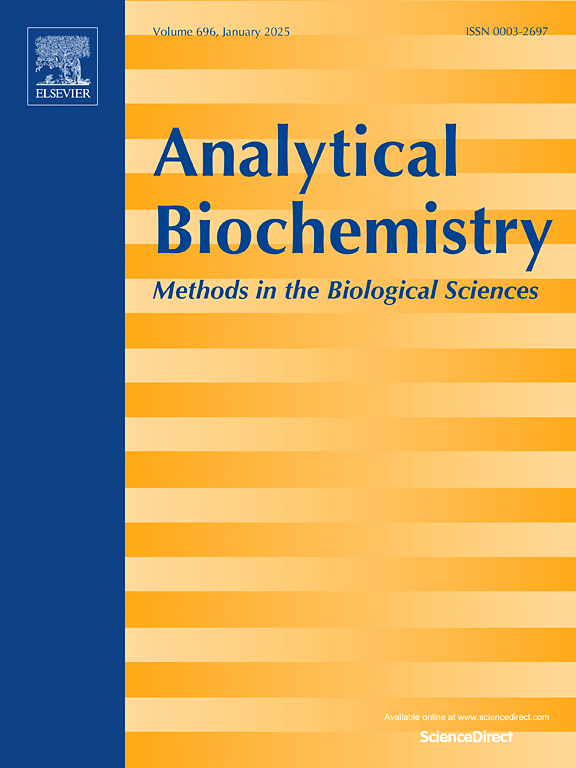Electrochemical determination of ascorbic acid using sensitive and disposable methylene blue modified pencil graphite electrode
IF 2.6
4区 生物学
Q2 BIOCHEMICAL RESEARCH METHODS
引用次数: 0
Abstract
In the present work, a convenient, efficient and disposable electrochemical sensor has been developed by electropolymerizing methylene blue (PMB) on the surface of a pencil graphite electrode (PGE), which facilitates the electrochemical analysis of an antioxidant l-Ascorbic Acid (AA). The structural characteristics of both the methylene blue modified pencil graphite electrode (PMB/PGE) and the bare pencil graphite electrode (BPGE) have been examined using scanning electron microscopy (SEM) in conjunction with energy-dispersive X-ray analysis (EDX). Additionally, the charge transfer behavior has been evaluated using the electron impedance spectroscopy (EIS). The voltammetric response of AA has been examined using different methods, such as differential pulse voltammetry (DPV) and linear sweep voltammetry (LSV). This exploration has been carried out in 0.1 M phosphate buffer solution (PBS) of physiological pH 7.0. The electrochemical sensor PMB/PGE proposed in this study exhibited an improved peak current and a slight negative shift in peak potential for AA compared to bare electrode. The enhancement in peak current at the modified electrode has been attributed to the electrocatalytic characteristics of the modifiers. The limit of detection (LOD) for AA has been determined using the differential pulse voltammetry (DPV), with concentrations ranging from 1.0 μM to 12.0 μM. The calculated LOD value has been found to be 0.15 μM. The selectivity and practicality of the modified electrode has been assessed through the real sample analysis and demonstrating its capability to detect AA in the presence of paracetamol (PA) resulting in satisfactory recovery results. Hence the proposed sensor could be successfully validated for the determination of AA in pharmaceutical sample.

一次性亚甲蓝修饰铅笔石墨电极灵敏电化学测定抗坏血酸。
本文通过在铅笔石墨电极(PGE)表面电聚合亚甲基蓝(PMB),研制了一种方便、高效、一次性的电化学传感器,用于抗氧化剂l -抗坏血酸(AA)的电化学分析。利用扫描电子显微镜(SEM)结合能量色散x射线分析(EDX)研究了亚甲基蓝修饰铅笔石墨电极(PMB/PGE)和裸铅笔石墨电极(BPGE)的结构特征。此外,利用电子阻抗谱(EIS)对电荷转移行为进行了评价。采用差分脉冲伏安法(DPV)和线性扫描伏安法(LSV)等方法研究了AA的伏安响应。本实验在生理pH 7.0的0.1 M磷酸盐缓冲溶液(PBS)中进行。与裸电极相比,本研究提出的电化学传感器PMB/PGE表现出更高的峰值电流和轻微的负移峰电位。改性电极处峰值电流的增强归因于改性剂的电催化特性。采用差分脉冲伏安法(DPV)测定了AA在1.0 μM ~ 12.0 μM范围内的检出限(LOD)。计算出的LOD值为0.15 μM。通过实际样品分析,验证了该修饰电极的选择性和实用性,并证明了其在对乙酰氨基酚(PA)存在时检测AA的能力,并获得了令人满意的回收率结果。因此,该传感器可用于药品样品中AA的测定。
本文章由计算机程序翻译,如有差异,请以英文原文为准。
求助全文
约1分钟内获得全文
求助全文
来源期刊

Analytical biochemistry
生物-分析化学
CiteScore
5.70
自引率
0.00%
发文量
283
审稿时长
44 days
期刊介绍:
The journal''s title Analytical Biochemistry: Methods in the Biological Sciences declares its broad scope: methods for the basic biological sciences that include biochemistry, molecular genetics, cell biology, proteomics, immunology, bioinformatics and wherever the frontiers of research take the field.
The emphasis is on methods from the strictly analytical to the more preparative that would include novel approaches to protein purification as well as improvements in cell and organ culture. The actual techniques are equally inclusive ranging from aptamers to zymology.
The journal has been particularly active in:
-Analytical techniques for biological molecules-
Aptamer selection and utilization-
Biosensors-
Chromatography-
Cloning, sequencing and mutagenesis-
Electrochemical methods-
Electrophoresis-
Enzyme characterization methods-
Immunological approaches-
Mass spectrometry of proteins and nucleic acids-
Metabolomics-
Nano level techniques-
Optical spectroscopy in all its forms.
The journal is reluctant to include most drug and strictly clinical studies as there are more suitable publication platforms for these types of papers.
 求助内容:
求助内容: 应助结果提醒方式:
应助结果提醒方式:


